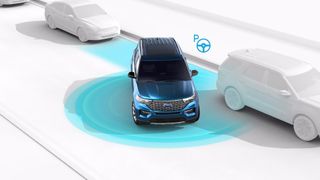Future Ford cars won’t do the parking for you anymore – and here’s why
Ford COO Kumar Galhotra has announced that Ford will be pulling the plug on some of its autonomous parking functionality to drive savings across the company.
Ford has a number of autonomous parking features, all based on Active Park Assist, which first appeared on the market about a decade ago.
With countless generations arriving along the way, the technology aimed to take the stress out of parallel parking situations, with the vehicle first detecting a suitable space using on-board cameras and sensors and then taking over driving duties, including acceleration and braking, to autonomously guide the car into it.
“Connected vehicle data is very important here because it helps us see what we are delivering, whether the customers are using it or not,” Galhotra said on a conference call last week, according to a Bloomberg report.
“An example is an automatic parking function that allows the customer to automatically parallel park. Very, very few people use it, so we can remove that feature. It costs about $60 per vehicle,” he added, referring to the savings Ford can make. on every car by dumping the system.
Ford’s COO went on to state that the cumulative savings will amount to approximately $10 million per year (£8 million / AU$15.5 million), although this figure could rise to $2 billion (£1.6 billion / AU$3 billion) if you consider the broader production, freight and material costs associated with producing and offering a technology like this.
However, Galhotra did not mention the precise name of the technology it planned to scrap, nor whether other autonomous features such as Adaptive Cruise Control (which uses a similar sensor suite) would be affected by the scrapping of ‘automatic parking features’. “.
Active Park Assist can currently be found on models such as the electric Ford Mustang Mach-E, the F150 pick-up and the compact SUV Escape. However, no mention has been made of a timeline for phasing out the system.
The great autonomous debate
Ford has tapped into a very interesting topic around high levels of automation in modern vehicles, and was one of the first manufacturers to ask the question, “Does anyone actually use this stuff?”
While the marketing bubble around new cars suggests that innovations like BMW’s Reverse Assistant are life-saving (the system remembers the last few meters of road in case you need it to reverse automatically), there’s no real evidence to suggest they’re any good. or if customers use it a lot.
Personally, most of the systems I’ve tried lately have been slow and clunky, often missing spaces and taking far too long to perform the maneuver in question. Many times I’ve disabled the system and taken over a reverse parking situation midway to spare myself the embarrassment of fellow motorists who assumed I couldn’t drive or were causing traffic in a multi-storey parking garage.
In this case, Ford is using data from its connected cars to learn what features its customers actually want and need. Although the scrapping of the hardware behind Ford’s Active Park Assist means the company also won’t be able to offer the functionality as an on-demand subscription package, as many manufacturers have suggested will happen with future in-car technology.
Either way, if it helps Ford keep unit costs down, the savings will also be passed on to customers, which will only increase consumer confidence in the current climate of overtly expensive electric cars.
Perhaps it’s best to leave autonomous functionality until cars can actually drive themselves. Everything else in the meantime is just a bit pointless and clunky.

